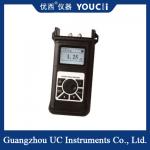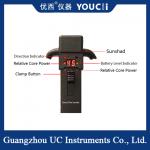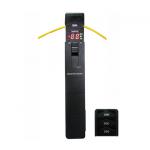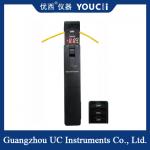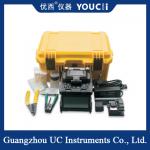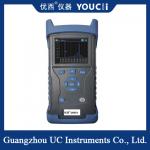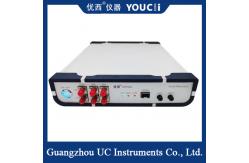100Gbps Multi-Frequency Division Clock Recovery Instrument
The U9764A CDR (Clock Recovery Instrument) is primarily used
to provide clock recovery signals in test environments where no
clock is triggered, thus testing the optical eye pattern of the
device with a sampling oscilloscope. Typical applications are the
testing of optical network devices, or for BOB products in PON
applications, since the optical device itself does not have a split
clock output, the clock signal needs to be recovered to trigger the
sampling oscilloscope when testing the optical eye map.
The U9764A CDR is equipped with an SFP28 optical port,
which is suitable for the conventional SFP28, SR, LR and BIDI
optical modules packaged with SFP28. Only the receiving end of the
optical module is required to convert the optical signal into an
electrical signal, and the CDR will extract the clock of the
electrical signal and output it. The clock signal is mainly used
for the trigger signal of the oscilloscope.
| NO. | Technical | MAX | MIN | unit |
| 1 | Data rate range | 28.1 | 25.6 | Gbps |
| 2 | Wavelength range | 1600 | 800 | nm |
| 3 | Optical input range (determined by module sensitivity) | +3 | -12 | dBm |
| 4 | Clock recovery output frequency division ratio | 2 / 4 / 8 / 16 / 64 / 256 |
|
| 5 | Output electrical clock amplitude | 800(Typical value) | mVpp |
| 6 | CML Clock differential output swing | 800 | 200 | mVpp |
| 7 | The clock output jitter randomly | 800 | 300 | fs |
| 8 | Clock frequency (28.1Gbps as an example) | 14.05 | 0.11 | GHz |
| 9 | Internal Signal Loss Detection (LOS) | 128 (Over duty) | 5(sensitivity) | mV |
| 10 | Power supply voltage (external power input voltage) | 5.5 | 4 | V |
| 11 | Operating temperature | 70 | 10 | ℃ |
| 12 | Adaptive module type | SFP28,SR,LR,BIDI |
|
What is a clock recovery device?
A Clock Recovery Unit is a device used to recover
clock signals in digital communications. In digital communication,
a synchronized clock signal is needed between the sender and
receiver to ensure correct data transmission. The function of the
clock recovery instrument is to extract the correct clock signal
from the received data stream.
Clock recovery instrument is usually used in optical
fiber communication, satellite communication, Ethernet and other
high-speed digital communication systems. In these systems, the
data is transmitted in digital form, and the clock signal is used
to determine the transmission rate and time interval of the data.
Due to possible problems such as clock jitter, clock drift, or
transmission noise during transmission, the receiver needs to use a
clock recovery meter to regenerate an accurate clock signal.
The working principle of a clock recovery device is
usually based on a Phase-Locked Loop (PLL) or related technology.
Based on the clock information in the received data stream, it
adjusts the local clock to keep it in sync with the sending end. By
constantly adjusting the frequency and phase of the local clock,
the clock recovery device can gradually eliminate clock offset,
thus achieving the recovery of accurate clock signals.
The performance and functionality of the clock recovery meter will
vary depending on the application and requirements. Some advanced
clock recovery devices may have adaptive functions, which can be
dynamically adjusted according to the characteristics of the
transmitted signal to adapt to different communication environments
and data rates. In addition, the clock recovery meter may include
additional features such as bit error rate detection, jitter
analysis, and clock output interfaces to help analyze and monitor
the performance of the communication system.In short, the clock
recovery instrument plays a vital role in the digital communication
system, it can extract the accurate clock signal from the received
data stream to ensure the correct transmission and synchronization
of data.
